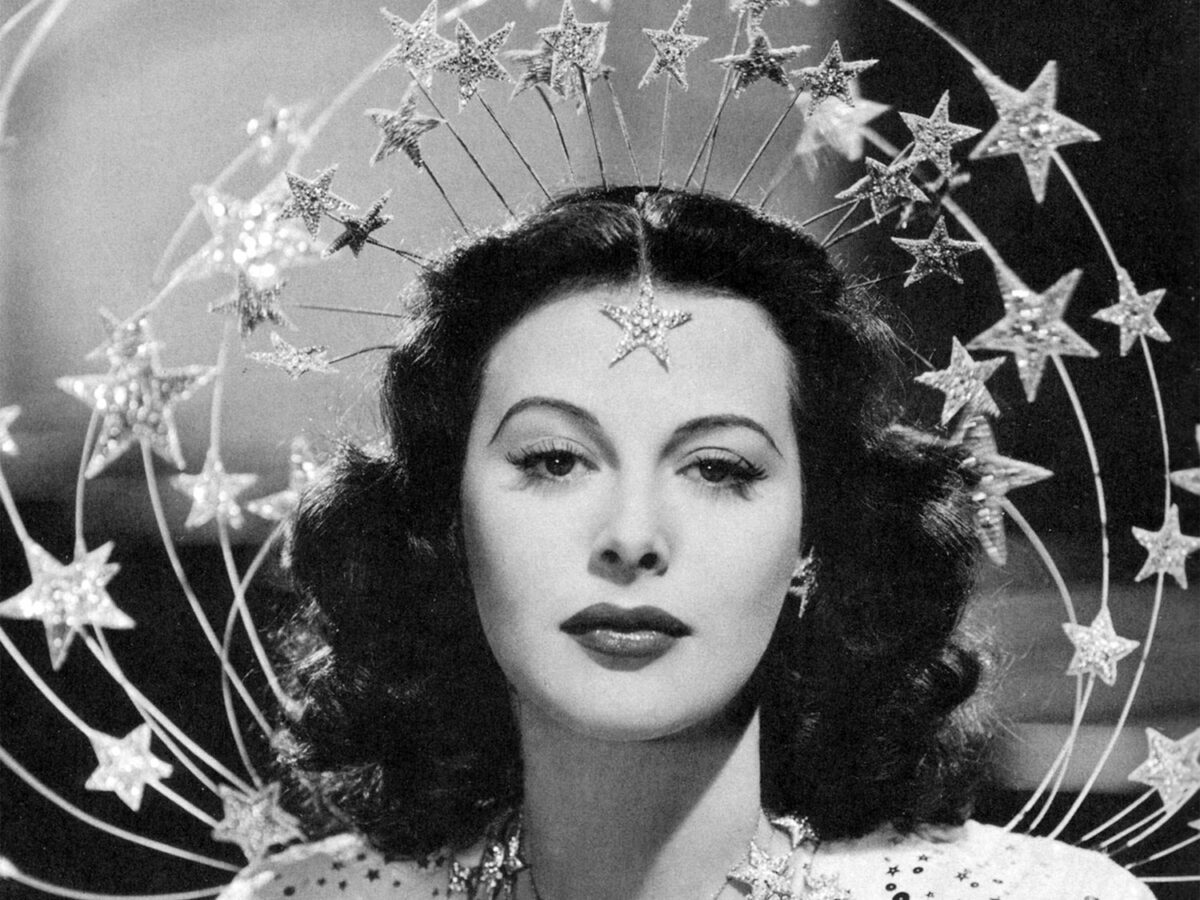Jay Leno and Bruce Meyer are each a powerhouse in their own right. While they’re uniquely driven, when it comes to cars, they both reign supreme. Their collections, filled with the automotive industry’s most rare, iconic and legendary makes and models, are coveted by motor enthusiasts around the world.
I recently spent the day with these influential car experts at Jay’s Big Dog Garage in preparation for this year’s Rodeo Drive Concours d’Elegance. What followed was a crash course in automotive history and design, and a rare glimpse inside their deep and enduring 50-year friendship, powered by the love of cars.
With Bruce’s encouragement, Jay invites me to take a spin in his 1909 Baker Electric car. Once inside the ornate Cinderella-esque carriage, Jay, at the controls, releases the brake, sounds the horn and with surprising acceleration, glides us through his astonishing 140,000-square-foot garage in Burbank, California. Filled with over 200 exquisite, exotic and eclectic cars, and 168 “finest in the world” motorcycles, Jay’s motor sanctum is different in presentation from Bruce’s across town in Beverly Hills. Built in 1926 on North Beverly Drive, Bruce’s pristine car palace (small by comparison) houses his extraordinarily curated treasure trove in the first and oldest garage in Beverly Hills.
Bruce Meyer’s family, referred to as “Beverly Hills royalty,” is considered one of the most influential families in Beverly Hills. Bruce’s father, Fred, together with his wife, Ruth, bought a small gift store in Beverly Hills called Gearys in 1953. Bruce joined his parents and grew the family business with a mail order division, an additional store and his entrepreneurial way of thinking. When his landlord offered to sell Bruce the building, despite his parents’ objections, Bruce made the first of his many real estate purchases. Today, his real estate portfolio encompasses key properties along Beverly Drive and Rodeo Drive in the heart of Beverly Hills’ business triangle.
Elevated to CEO of Gearys in 1977, Bruce amplified the charge for Gearys becoming the iconic Beverly Hills retail center for distinctive home goods from the world’s finest artisans. His curated ideals for top-flight luxury were maintained throughout his 20 years, only to be further enhanced by his nephew, Tom Blumenthal, who began working in the family business at age 13. Today, Tom is the owner, president and CEO of the preeminent Gearys, and Bruce remains on its Board of Directors with his son, Eric, a United States career diplomat. His other son, Evan, a successful real estate developer, is the incoming chairman of Beverly Hills Architectural Commission. And Bruce’s cousin, Craig Corman, is a newly elected Beverly Hills City Councilmember.
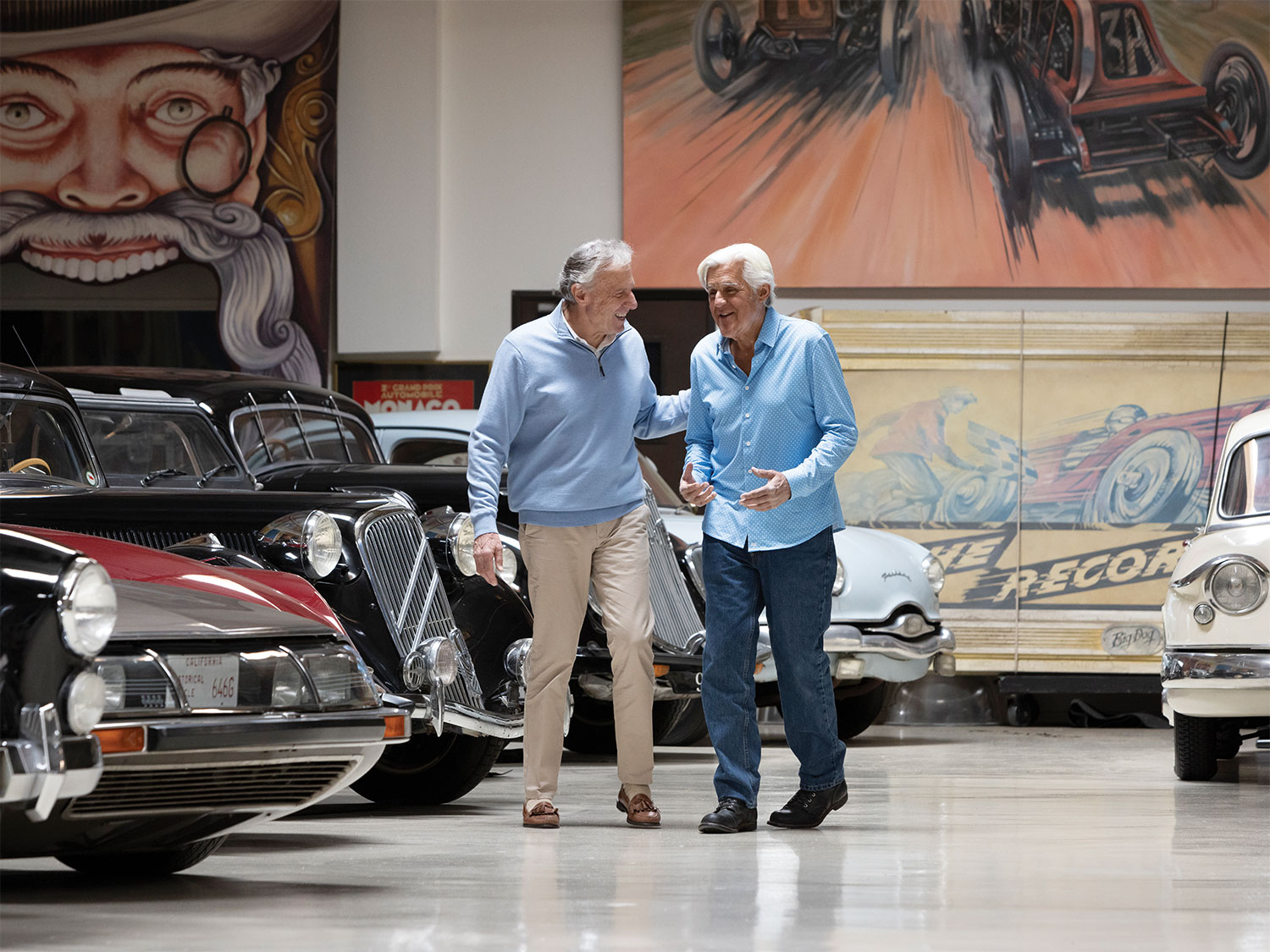
Photo by Evan Klein
Jay Leno was born James Douglas Muir in New Rochelle, New York to Catherine, a Scottish immigrant, and Angelo Leno, an insurance salesman from a big Italian family. Jay was raised in Andover, Massachusetts and laid the groundwork for telling jokes among this sizeable built-in audience. While attending Emerson College in Boston, a young, determined Jay traveled regularly to New York to audition at the Improv and other comedy clubs. Oftentimes, the endless wait to present his stand-up comedy act took the whole day. But Jay persevered, believing in patience and the commitment to work hard. Eventually, he moved to California to make a go at comedy.
Throughout the ‘70s and ‘80s, Jay appeared in television shows and feature films, but his breakthrough came in 1986 when he was asked to become a regular substitute for the legendary Johnny Carson on the “Tonight Show.” Adored by the masses, in 1992, the NBC network executives chose Jay to permanently replace Carson. For more than 20 years, viewers in 5 million homes welcomed Jay into their lives every night. Except for a hiccup in 2010 with Conan O’Brien, Jay remained the nighttime top dog for NBC until 2014, entertaining generations of audiences around the world.
Wanting to share his car knowledge, Jay created an original series for NBC.com set in his Big Dog Garage. Within a year, it became a weekly prime-time show on CNBC for which Jay won a Primetime Emmy Award in 2016. After seven years, the show was canceled, but Jay pressed on. Today, through an active YouTube channel, he produces “Jay Leno’s Garage,” a series with over 3.63 million subscribers and over 900 million views, proving he’s the man of car influence.
Their respect for each other is palpable. It began in the early 1970s before Jay and Bruce were successful. They frequented car rallies with other car hobbyists looking to talk about cars. Bob’s Big Boy in the San Fernando Valley was one of their main haunts.
Jay posits, “I say women have friends; men have allies. Men find men who can help them do things. Then, they can do things for them. And then, you become friends, like, ‘Oh, I can help you with this. You help me with that.’ Most of my friends are people who can do mechanical things much better than me, and I help them because I’m in show business. It’s fun for them to come to a TV show, and they can bring their families.”
Bruce and Jay’s generosity of spirit is as aligned as their natural attraction to cars.
“I think the genesis of all this comes in your genetic makeup,” says Bruce. “I would be willing to bet Jay loved cars from day one, like me. My mother made a note in my baby book. ‘Bruce loves anything with wheels.’ I have three children. One of them is a car person. The other two don’t share the passion. There are people that just don’t relate to this. And there are people who do. It’s a mutant gene; I mean you can’t take the car out of me.”
Jay ‘‘pretty much” agrees.
He jokingly adds, “It’s how you got from one place to another. I mean, being 15 ½ [years old] was the worst because uptown was seven miles riding my bike. And the guy who’s six months older, he drives by with five girls in his car, and he’s waving. When I got there on my bike, everybody’s left!”
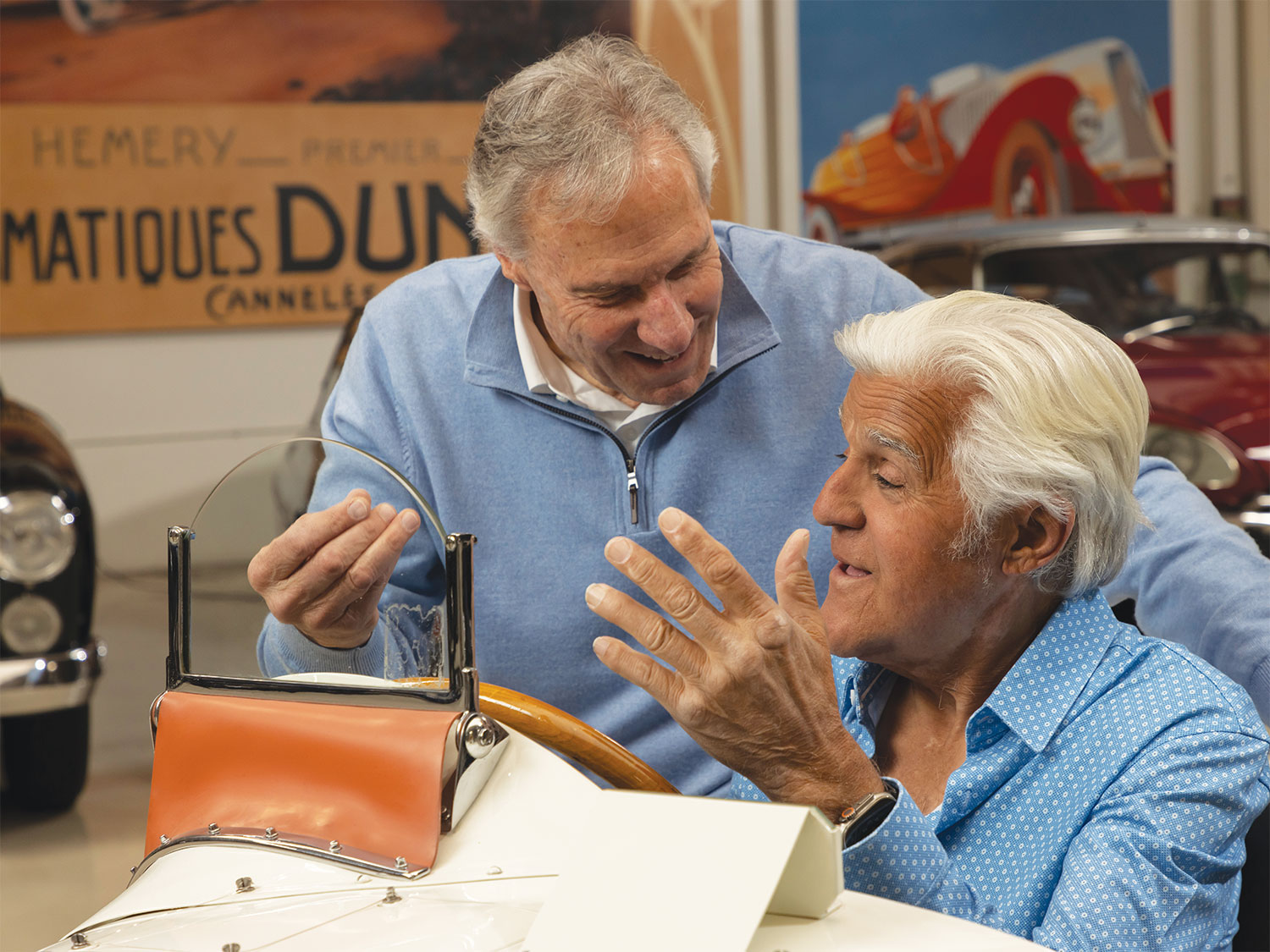
Photo by evan klein
Believing cars were a waste of time and money, Bruce’s father had little regard for his son’s fascination. Still, Bruce, the ever-resourceful “go-getter,” worked hard doing odd jobs during high school to earn enough money to buy his first motor vehicle, a 1950s BSA scrambler motorcycle. Storing it at a friend’s house, Bruce clandestinely raced on the weekends without his parents finding out.
An avid reader of Hot Rod magazine, Bruce dreamed of building and owning his own hot rod. Despite the low cost, $100-$200, his parents forbade him from buying one. But when his great aunt passed away and left him a ’50s Plymouth, Bruce eagerly created and built his first version of a hot rod.
While at UC Berkeley working on his degree in business, the industrious young man tended bar, bussed tables, sold embossed stationery and borrowed money on an interest-free student loan even though his father paid his tuition in full. Clever and tenacious, Bruce used the cash to buy and race motorcycles, eventually selling everything for a profit.
Returning home, his passion for cars would not let up, even after he entered the family business. Impressed with his son’s business acumen, Fred finally broke down and helped Bruce buy his first car, a 1961 Porsche 356 for $2,700.
When Jay was 14 years old, he and his father saw a 1934 Ford Pickup sitting at a gas station attached to the Tip Top Miniature Golf in Reading, Massachusetts. And like Bruce, Jay’s father did not see the point in buying a car other than for functionality. Worse yet, this particular 30-year-old car did not move. Jay was undeterred and $350 later, he owned his first car to restore.
“Rosebud” was his first car in California, a 1955 Buick Roadmaster coupe. It was his mode of transportation during the 1970s and often a part of his comedy routine. Most importantly, it served as his chariot on his first date with his wife, Mavis.
It was 1976 when Jay stepped off the stage at the Comedy Store in Los Angeles and into Mavis’ life. She was actually in the waiting area of the ladies’ room, near where the comedians hung out when their eyes met. She told People magazine in 1987, “With Jay, I began to realize that this was the first time I was ever with someone where I had a perfect, calm sense of having arrived at my destination.” They were married in 1980.
Mavis has been by Jay’s side ever since. An activist on the Feminist Majority Foundation Board of Directors, she has been their campaign chair to stop gender apartheid in Afghanistan. Earlier this year, Mavis was diagnosed with advanced dementia, and in a Los Angeles courtroom in April, Jay was granted conservatorship to ensure her future care.

Photo courtesy of bruce meyer
Eight years before the Lenos first met, Bruce was introduced to Raylene, the love of his life. The year was 1968. On their first date, before dinner, Bruce took Raylene to see a Porsche he was considering, setting the stage for the next 56 years together.
Back then, before helmets and other safety precautions were required, Raylene would regularly ride with him on his motorcycle. She admits, “We all do kind of silly things when we’re young.” Married on Bruce’s parents’ wedding anniversary in 1970, they have gone on to share a wonderful life filled with three children, seven grandchildren, and trips to car rallies all over the world. Raylene adds, “The most important thing to Bruce is all the people he has met with regards to collecting the cars and the hobby. He loves people.” When asked about the dangers of being married to a man who liked to ride and race, Raylene said, “I was like a Pollyanna; everything’s going to be fine. I didn’t worry about him going fast in cars or anything. But I would say my prayers beforehand. I just knew that he would be fine.”
Back inside the 1909 Baker Electric, Jay and I cruise onto the streets of Burbank as he hands me the car’s manufacturer’s manual.
“These were women’s shopping cars,” he says.
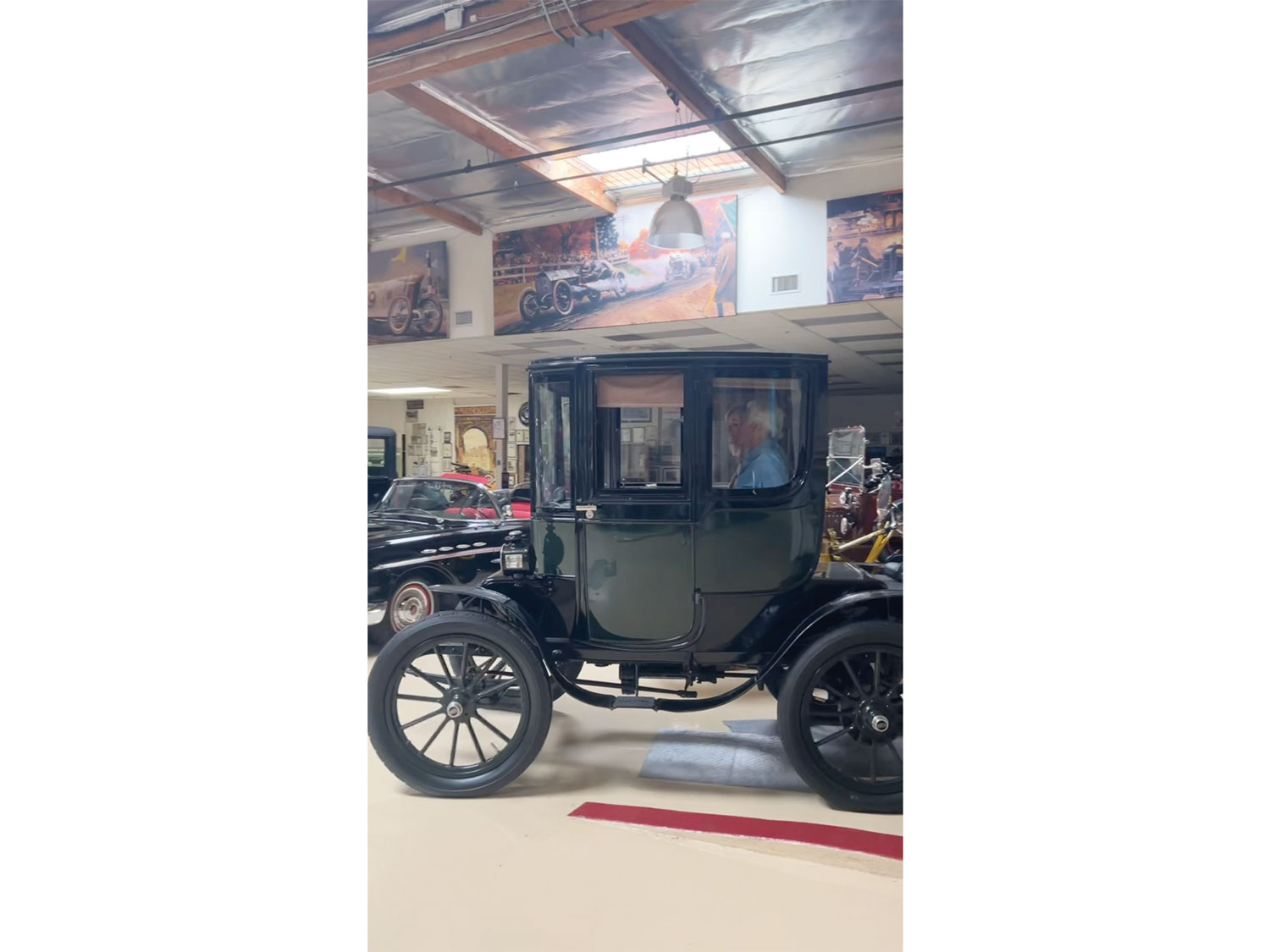
Photo by Katie Hicks
Made and marketed for wealthy men’s wives, the electric cars did not need to be hand cranked. Ads were placed in publications such as Colliers or other fashion magazines, entirely directed to women, for the electric “horseless carriage.” Replete with floral fabric-laced interiors, make-up compartments for face powder and room in the carriage for shopping bags, the cars did not leave a mess on the garage floor from dripping oil. Back then, a man would not be caught driving an electric car.
“We had electric cars before we had gas cars. But don’t forget, most people didn’t have electricity. Electricity was harder to come by than gasoline. In 1909, only rich people had electricity. But in New York, there were hundreds of electric taxis. In fact, in 1907-08, a third of the cars were steam, a third were gasoline and a third were electric. And they didn’t really know which one would win out.”
The inability to welcome change is often the challenge for innovation and adaptability.
“There’s something called the ‘shock of the new.’ You can’t sell something before it’s time. It’s called a horseless carriage for a reason. It looks like a carriage. Oh, but there’s no horse. What? Oh, OK.”
As we return to the garage, passing through the main gateway, Jay explains he’s not a collector, as he never sells his cars. But he does believe they’re a good investment.
“I bought the McLaren over there.”
He points to a black car in a line of cars as he maneuvers the crank to back the Baker Electric into its parking spot.

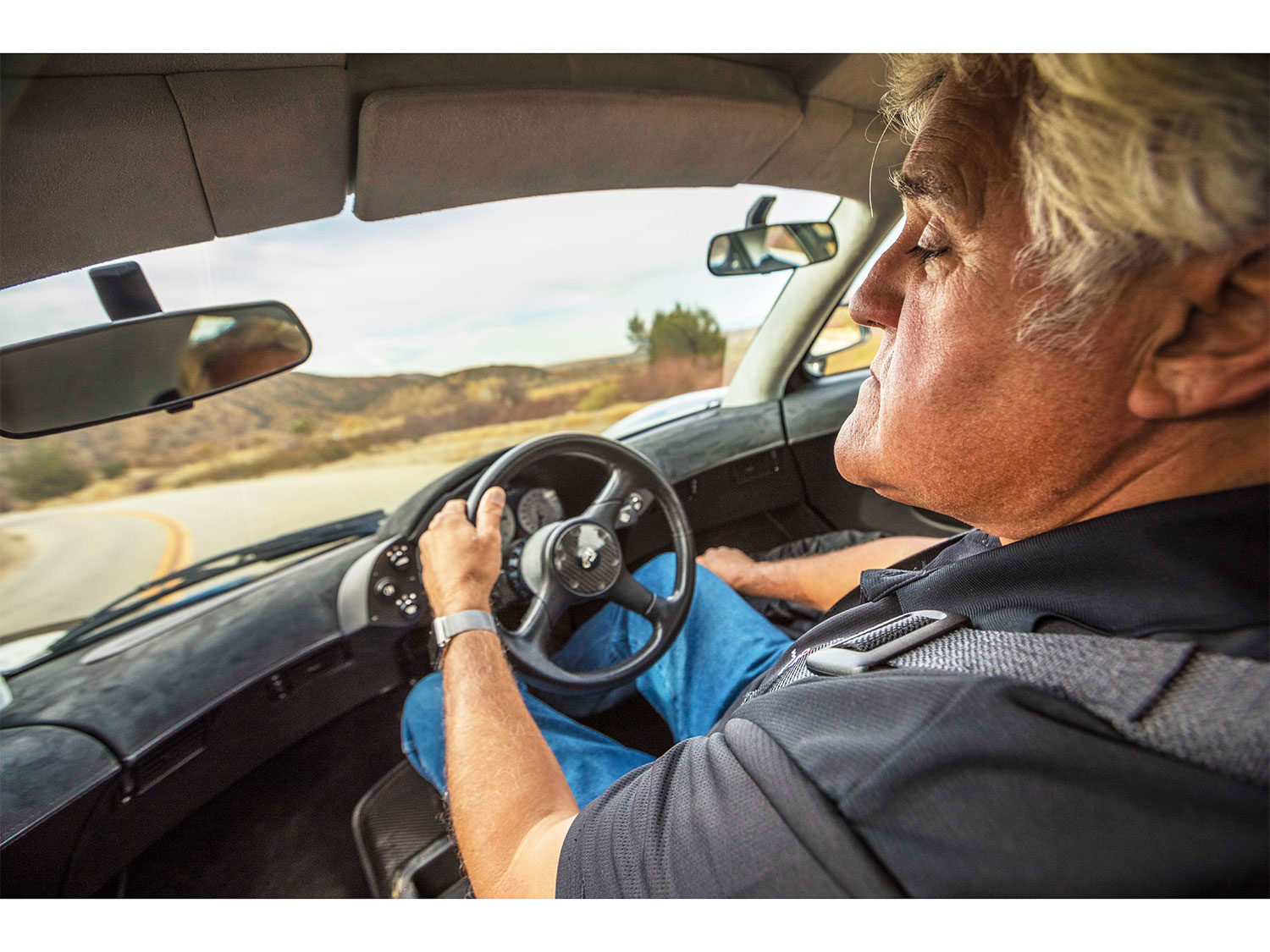

Photos by Evan klein
“I bought it for $800,000 in 1998-99. And the last offer I got was $20 million. So, that’s certainly a good investment. You know what I mean? It’s like anything. If you’re reasonably knowledgeable and you like it, chances are other people will like it, too. And they tend to go up in value. The idea of making money collecting cars is fairly new in the sense that you just did it because you like them. The fact that they go up in value, it’s just an added bonus.”
In the United States alone, the market for vintage, classic and exotic automobiles is estimated to be $1 trillion. That figure represents about 16% of the value of the 275 million registered vehicles in the United States. In 2021, North American collector car auctions generated $2.2 billion in sales. In 2023, seven vehicles were offered for over $10 million, which contributed to the $3.4 billion figure spent in North American auctions. And in 2024, these figures are predicted to rise precipitously.
Bruce joins us in the garage’s living room-like setting surrounded by Jay’s motorcycle collection, as Jay explains how motoring was a life changer for him. “I always prided myself; I was always able to get a car home. By that I mean, if I’m broken down by the side of the road, with a piece of twine and some wire, I could get it back to my house to fix it. [With] modern cars now, you don’t carry a toolbox. You just carry a cell phone, and the tow truck comes in because it’s so complicated and so electronic.”
Jay believes this is why young people today are not bonding with automotive functionality. Simple mechanical systems have been replaced with technological advancements. This was not the case in Jay’s and Bruce’s youth.
“You’re controlling your own destiny,” says Jay. “When you have something that’s broken, and you make it work and you fix it. I think there’s a great deal of pride in that. And satisfaction.”
Bruce highlights his friend’s natural talent.
“Jay is absolutely curious about what makes things work. He works on his own cars. I wish I had his level of talent in that regard. I love the aesthetic. I think I bought the right cars just because they appeal to me. I love to drive them. I’ve raced Bonneville. I’ve raced motorcycles. I enjoy the whole thing about cars. Jay does as well. But Jay, when you see this other room, I mean this is not like my garage where nothing gets done.”
Next door to Jay’s Big Dog Garage is his restoration and maintenance facility. There, talented and expert coachbuilders work with Jay to preserve his fleet.
“You’re saving a piece of history,” Jay believes.
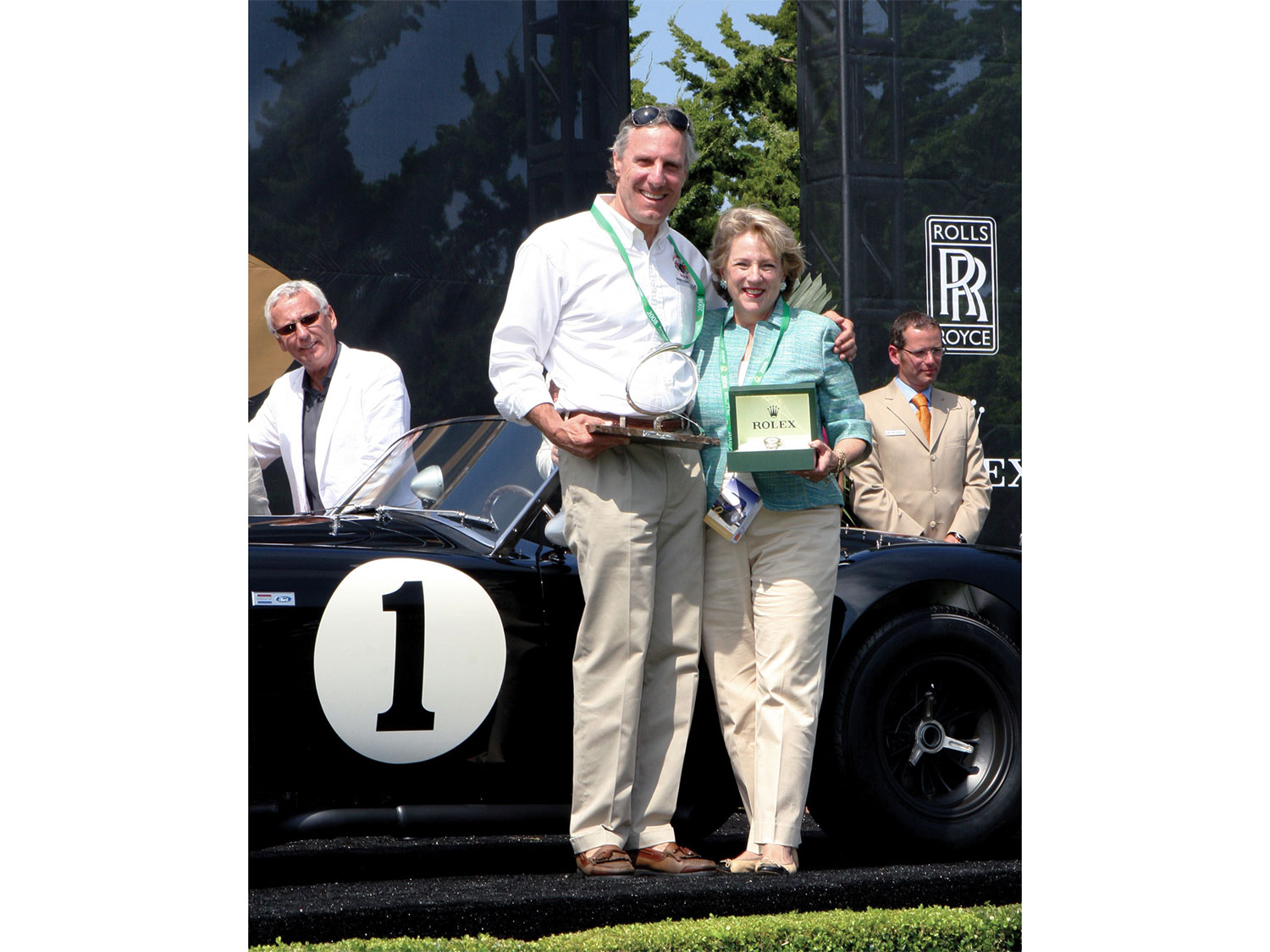
This phenomenon can be seen in Bruce’s garage in Beverly Hills. There, you quickly understand the depth of his knowledge and his curating mastery. Even a nonenthusiast would be fervently impressed with the diversity of genres, historical importance, and the shapes and colors of every car on display. Each piece has a remarkable story, from the Porsche 935 K3, which was the first production car to win overall at the 1979 24-Hours of Le Mans, to the bright yellow 1967 Ferrari 275 GTB4 that was bought new by Bill Doheny (of the Beverly Hills Doheny family and Greystone Mansion). Don Prudhomme’s first slingshot dragster is there along with Clark Gable’s gorgeous tobacco brown 1956 Mercedes 300SC and the iconic 1955 Mercedes Benz Gullwing Coupe. It’s hard not to be in awe of this collection, which was 50 years in the making.
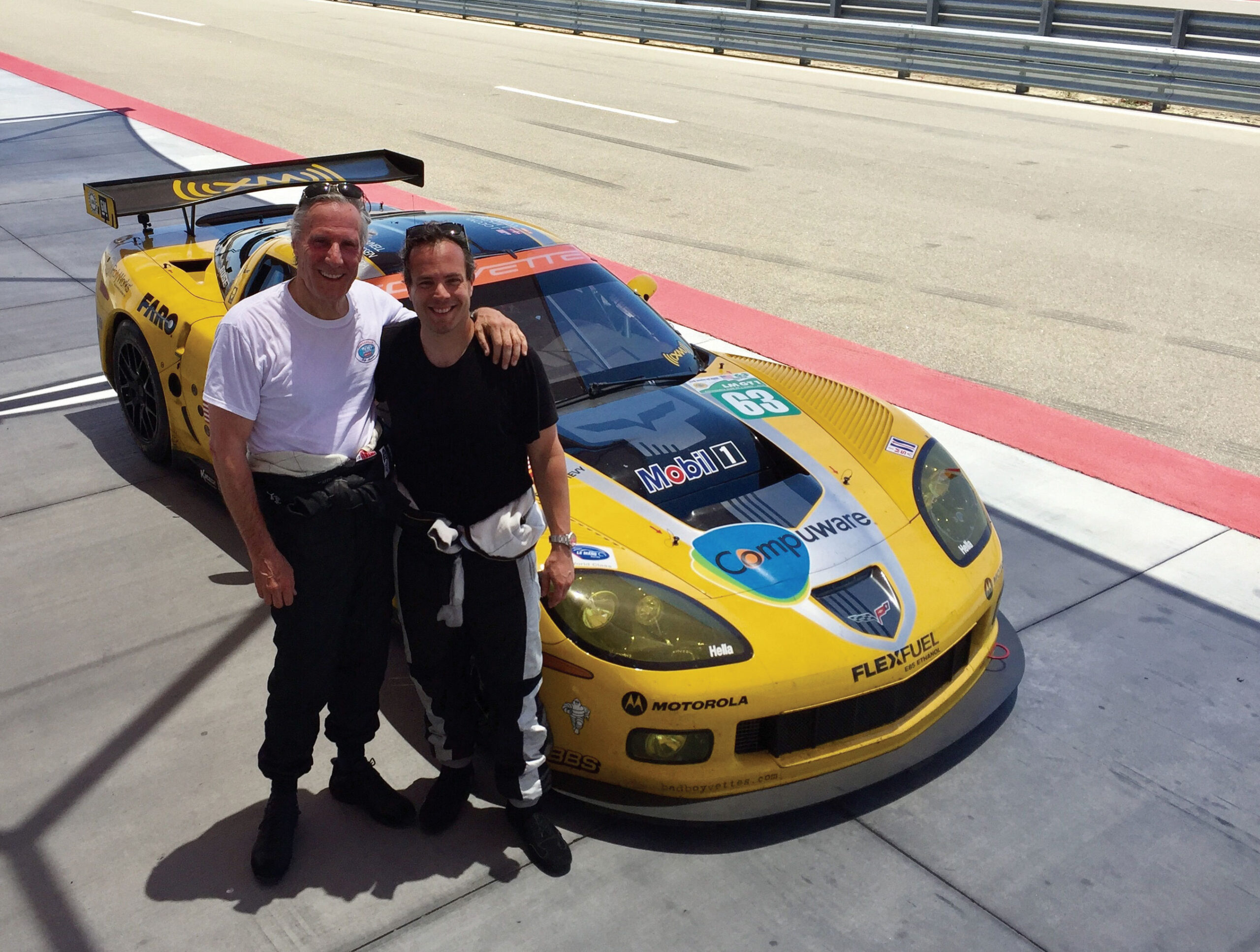
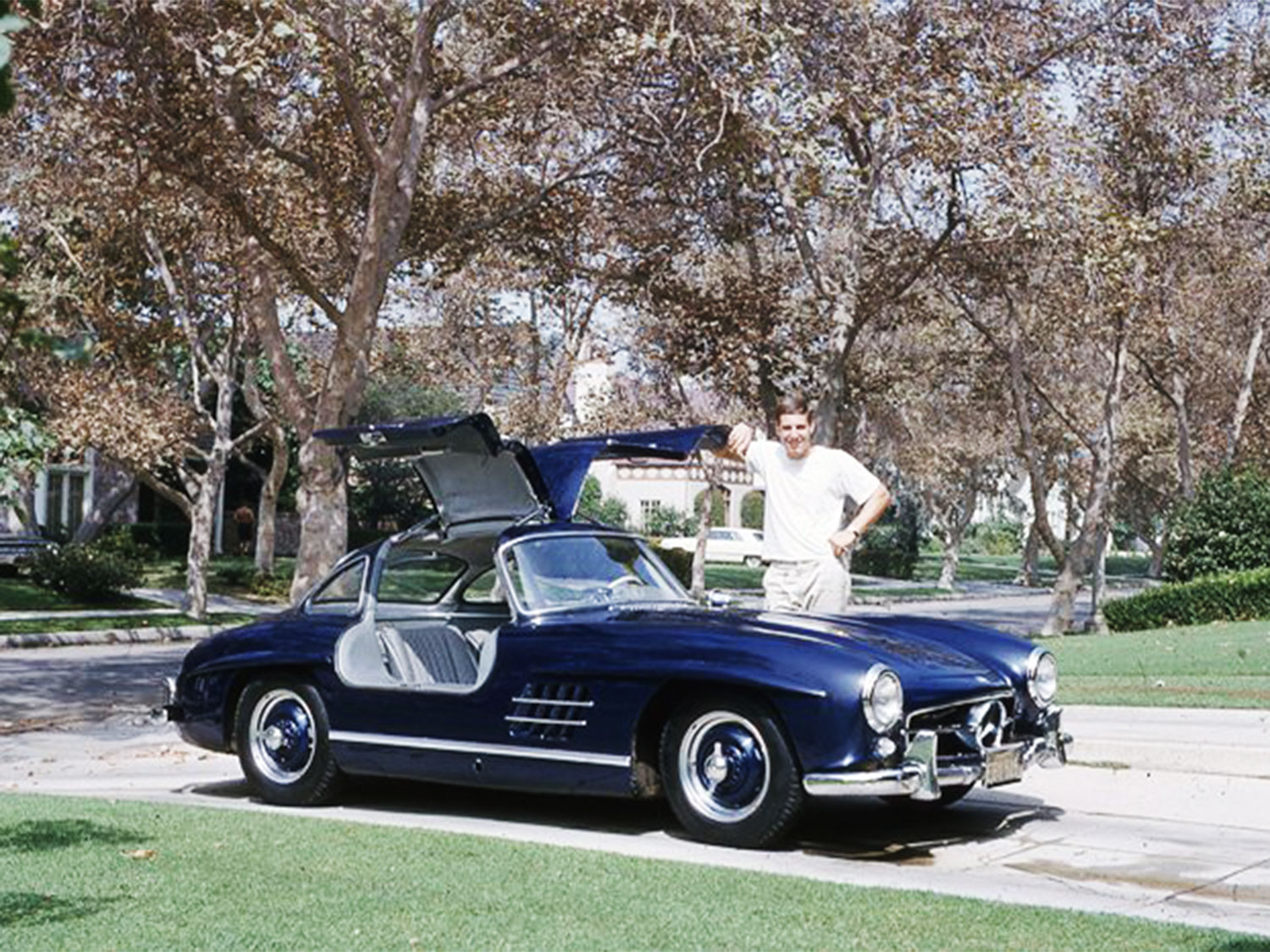
Photos courtesy of bruce meyer
When asked in the press about the perfect car, Bruce responded, “If you could have one car, I don’t see how you could do better than a Gullwing. The build quality, the workmanship, the rarity, the beauty.”
Jay expands on that notion.
“It’s seeing cars as art… It is only fairly recently, by recently, I mean the last 30 years, that cars are seen as art. The Guggenheim Museum did a motorcycle exhibition about 25 years ago, and it is still one of the biggest exhibits the museum ever had.”
Bruce chimes in, “Otis Chandler’s motorcycles went to the Guggenheim for that event. And a year ago, the famous architect Lord Norman Foster [the architect for One Beverly Hills] did an exhibit at the Guggenheim in Bilbao. He picked the cars and had the biggest gate they’ve ever had for an exhibit.”
Although their areas of focus are somewhat divergent, both enthusiasts agree that pre-1970s is their favorite era for cars.
“I’ve focused more on race cars. I like cars with competition history. Almost every car I have is a race car or has some nexus to racing,” Bruce says. His motto, “Buy the best example of what you want, and pay whatever it takes. That way you cry only once.”


Photos courtesy of bruce meyer
He has other cars that invoke elegance and prestige such as the Clark Gable Mercedes, personalized with the actor’s engraved Saint Christopher’s Medal on the glove box and custom Mercedes luggage with Clark’s personalized tags.
“They made 48 of these cars for royalty. The Shah of Iran had one, Gary Cooper, Errol Flynn, Bing Crosby. It was the most expensive car of the day, selling for $16,000 in 1956. And it’s always been one of my favorites. It’s my wife’s favorite car. She’s said that if I sell that car, she goes with it.”
While Bruce is drawn to the aesthetic component of automobiles, Jay is drawn to the cars he finds different, interesting or ahead of their time. He’s particularly interested in “noble failures.”
“Like the Duesenberg, it was a much better car than it needed to be,” Jay says.
Produced during the Depression, it was too expensive of a car, over-engineered and overpowered for its time. The company was owned by E.L. Cord, another Beverly Hills resident. Jay has many Duesenbergs; Bruce owns one as well. Both enthusiasts have received several awards for their beautiful cars.
Jay explains, “That’s the trouble with a lot of these things. Some people don’t make it up to any standard. And some people make it so good and are perfectionists, they never get them into production.” He cites the Mustang as an example, “It’s a sexy body on a Ford Falcon. It didn’t need independent suspension for the first 25 years because nobody cared. Just make it look sharp. It’s kind of cool. It’s affordable. It was a huge success.”
Abiding by his moniker “never lift,” as in “never take your foot off the gas,” Bruce exhaustively pursued bringing the deserved recognition to hot rod cars and their makers.
“A hot rod is sort of a customized automobile. You take bits and pieces of different cars, and you make the car something faster, with better handling, than it was. But it was never recognized as a class. Bruce is really the guy that did that.”
Jay searches for an analogy.
“It’s like music versus rap. You had Mancini and all those people winning the Grammys and well deserved obviously, but rap music was sort of the hot rod child of music. It really wasn’t considered music initially. Bruce is the guy that said, ‘Hey, these hot rodders, these are real engineers.’ They learned on the back streets. Now, hot rods have become hundreds of thousands of dollars, which sort of defeats it. The idea was you did it with almost no money, just parts that you could find. And you used your will, and your skill and your technique with welding. You saw these old racers from the ‘50s and ‘60s who used to be harassed by the police for speeding. Suddenly, now they’re being honored. It was nice to see them get the recognition they deserve, to see the hot rod be recognized as an art form. Bruce is really the guy that made that happen.”
Bruce responds, “That really warms my heart.”

Photo courtesy of bruce meyer
After 10 years of Bruce championing the cause, in 1997, he convinced the organizers of the founding Concours d’Elegance in the United States, at Pebble Beach, to create a class for hot rods. Not surprisingly, Bruce won the class with his Doane Spencer hi-boy. Today, it’s a permanent class at Concours events around North America.
The Concours d’Elegance shows have served as entry points into the automobile industry. The “competition of elegance” dates back to 17th-century France during the Belle Epoque era, “a period marked by cultural refinement and artistic flourish.” Wealthy aristocrats and social elites would gather at grand venues, fashionable resorts and parks in France to display their luxurious carriages. Eventually, automobiles replaced the horse carriages as the mode of transportation.
Bruce and Jay are regular presenters at Beverly Hills’ annual Father’s Day event, Rodeo Drive Concours d’Elegance. It’s the epitome of our modern-day, family-oriented holiday. Last year, over 45,000 people in the sparkling sunshine, along with their pooches, walked Rodeo Drive and admired some of the finest automobiles in the world.
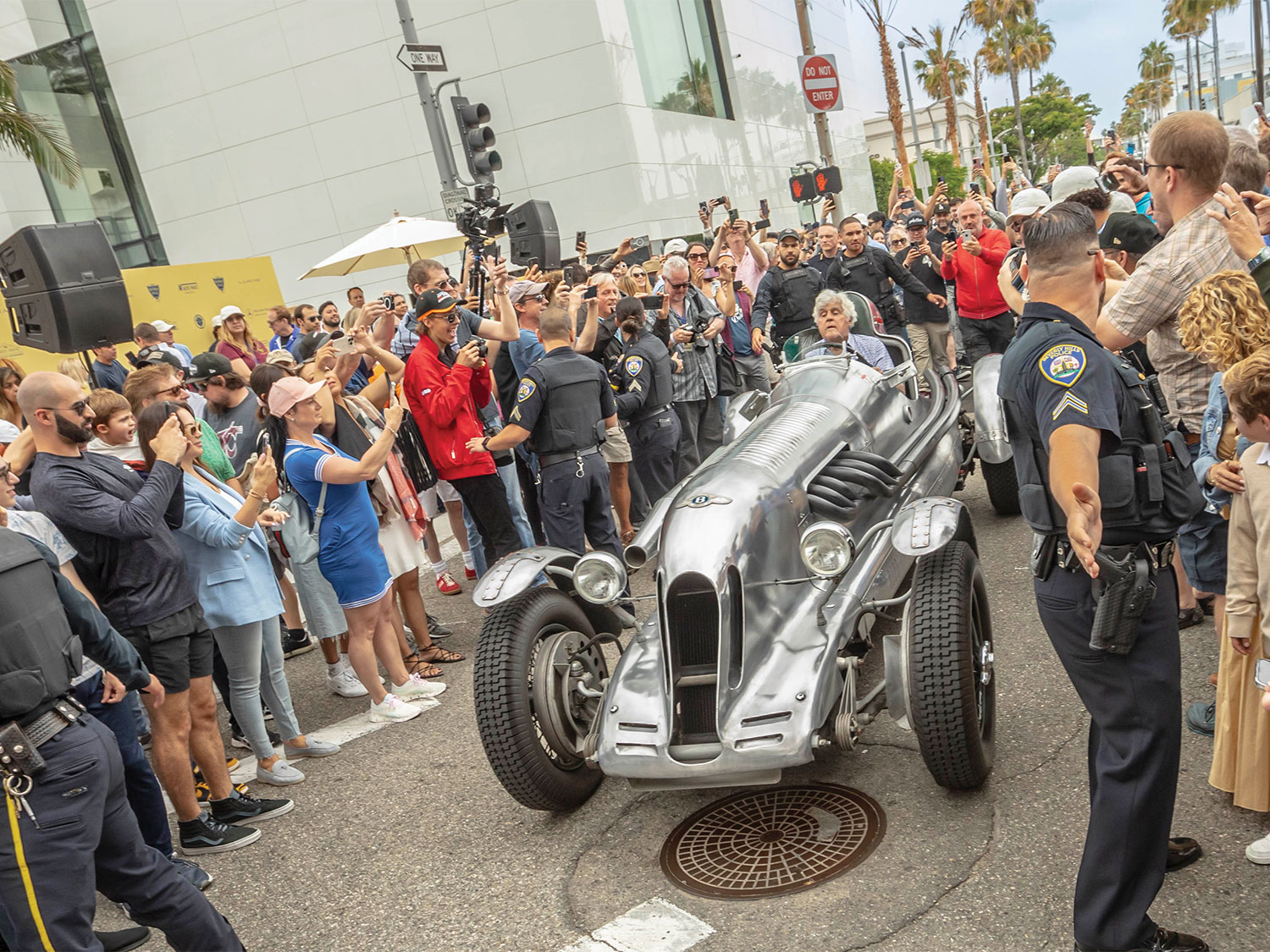
photo by evan klein
Originally, the Beverly Hills Concours d’Elegance sprang from a fundraising effort to restore the only remaining Beverly Hills 1928 Ahrens Fox fire engine, referred to as “The Fox.” Bruce led the fundraising charge. Soliciting the help of the community’s car enthusiasts and the Rodeo Drive Committee, the group convinced the City Council to approve bringing the Concours d’Elegance to Beverly Hills on Rodeo Drive. The inaugural event took place in June of 1993. Every year since, it’s touted as the most popular day in Beverly Hills and has become a Father’s Day tradition. On June 16 of this year, the 29th annual Concours d’Elegance returns with Bruce as chairman. Bruce and Jay will join the Beverly Hills Mayor and City Councilmembers in the winner’s circle, announcing this year’s award winners, with the restored Fox firetruck showcased nearby.
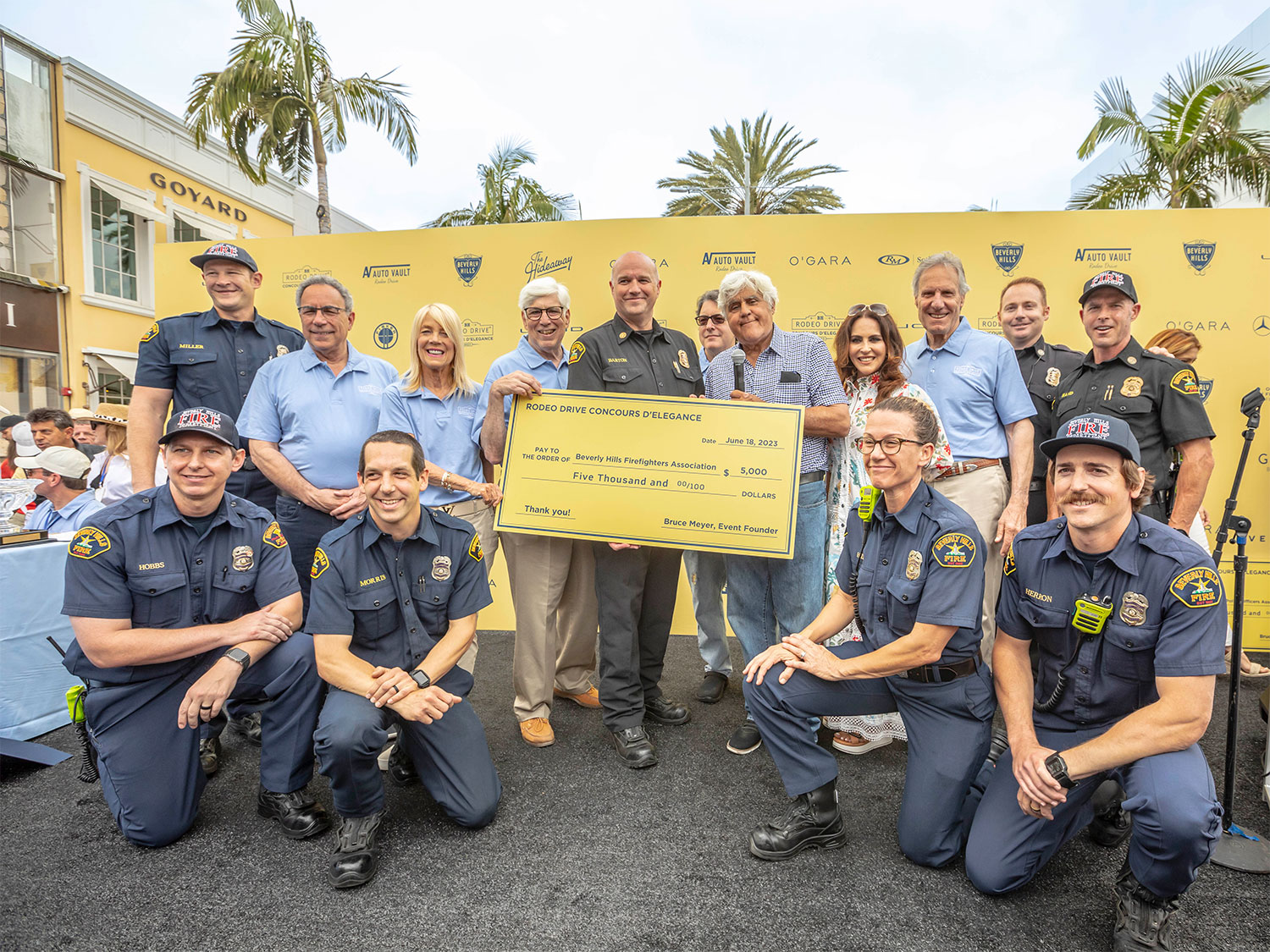
photo by evan klein
For Bruce, philanthropy is a big part of his life. Among his long list of honors, he’s a Founding Board Member of the California Highway Patrol 11-99 Foundation. Presently, he’s on the Board of Trustees at St. John’s Medical Center and generously involved with Children’s Hospital Los Angeles. When the Petersen Automotive Museum opened its doors in 1994, Bruce was its Founding Chairman. Today, the “Bruce Meyer Family Gallery,” within the museum, honors his enormous personal commitment and legacy. The Petersen Museum’s namesake, Robert E. Petersen, was also a Beverly Hills resident and the publisher of Hot Rod magazine. This coming October 2024, Bruce will be the honoree at their 30th Anniversary Petersen Fundraiser Gala, dubbed the Automotive Party of the Year.
Both Bruce and Jay are recipients of the Lee Iacocca Award. Among Jay’s charitable focuses, he’s honored those who helped him along his career path with scholarship funds, as well as supported war veterans, and victims of the Sept. 11 attacks. He has received two Emmy Awards, two TV Guide Awards, one People’s Choice Award and the Mark Twain Prize for American Humor. He’s also earned two Honorary Doctorates of Humane Letters, one from his alma mater Emerson College in 2014 and one from the Academy of Art University in 2021.
“Jay has been awesome. He has raised more money for the California Highway Patrol and for the Petersen Automotive Museum. He’s very generous with his talent. There are other people of fame that just don’t give back like Jay does. And he’s a great citizen. For the police department and the fire department, he’s done shows. There are people that just don’t get it, but Jay does.”
Jay responds, “I’m a huge believer in low self-esteem. It’s the key to success. If you don’t think you’re the smartest person in the room, then you should listen. I mean, there were 4,000 recorded geniuses in history, and I met 3,900 of them here in Beverly Hills.”
More seriously, Jay says, “The trick is to know what your limitations are. If I have something that can help others, that’s great. Maybe they’ll help me in some way. I don’t have to ever ask for it. It just works out nice. Bruce knows everybody. So, if I need a doctor, I call Bruce and ask, ‘Who’s a good cardiologist?’ ‘Oh, this guy’s the best cardiologist.’ ‘Oh, thank you, Bruce. I appreciate that.’ And then he’ll say to me, ‘I need a comedian…’”
“When Jay calls and he needs something, it makes me feel like I have some value in his life.”
Not only is he generous, but Jay also enjoys spreading joy. Most Beverly Hills residents and tourists have spotted him cruising around town in one of his prized motorized machines.
Jay offers, “I hate the fact that they’ve driven the film industry out of Beverly Hills, out of Hollywood. Everybody’s in Atlanta or somewhere else. When people come here, they expect to see something Hollywoodish. If I’m driving the Duesenberg or something like that and the tour bus goes by, yeah, I’ll pull over. I’ll take pictures with people. I like that. It’s fun.”
“There are more people who have climbed Everest than members of the 200 MPH Club.”
– Bruce Meyer
He recalls, “One day I’m driving in Beverly Hills, and I see Peter Falk. I pull over and I said, ‘Peter, hey, how you doing? Can I give you a lift home?’ He thought for a moment and said, ‘I got this Mercedes. It’s been sitting there [at the house] for years. I don’t know what’s wrong. But you will.’ So, I drive him back to his house. We pull in, and he’s got a nice Mercedes, one of the convertibles, and I got in. I said, ‘Well, the key is in, but the battery’s dead. Lemme go and get jumper cables.’ So I go to my house, get jumper cables, come back. I put the jumper cables in, the lights go on. I say, ‘Peter, here’s the problem, you left the lights on.’ Immediately, he becomes Columbo. He said, ‘Son of a…’ He goes and walks in a circle, comes back to me and says, ‘You’re telling me I left the lights on?’ I’m sitting there watching this. He just took on those mannerisms of the character. It just made me laugh. That’s the fun thing about living here.”
The chance of seeing two show business stars talking on the street is a rarity in any town. It’s as unusual as finding people who have joined the 200 MPH Club.
“There are more people who have climbed Everest than members of the 200 MPH Club. That’s a statistic told to me by a member of the club,” shares Bruce.
He is a proud member. The club’s association qualifies the drivers and provides the red hats, the badges of honor, for members to wear at automobile events.
“To join the 200 MPH Club, you have to break an existing land speed record over 200 mph that had been previously set. In other words, in the category of cars, there are some cars that go 400 mph, and there are some cars that set records at 90 mph. They have lots of different categories, engine sizes and a variety of cars. For the club, you have to go over 200 in a car that set a record,” says Bruce. “I drove a Camaro. It was 206 mph against the 197 record.”
Bruce’s second time was driving the 1932 hot rod that he built. In this case, his goal was to exceed 200 mph in an open hot rod, and he accomplished his goal.

photo by evan klein
Jay is not a member of the club, although he’s driven over 200 miles per hour many times. One such time, he took his C7 Corvette to Milford Proving Ground at General Motors and met with the head engineer to test the car.
“We get in the car and before the seat belts went on, I said, ‘Before we start, tell me the first time you ever went 200 in a Corvette.’ He goes, ‘Oh, I never have.’ I said, ‘You never have?’ He goes, ‘No, I’ve never been driven in a Corvette.’ ‘So, the first time is with a 73-year-old comedian in a car that I’ve never been in? On a track I’d never driven on?’ He goes, ‘Yeah, I guess so.’ ‘Okay, fine.’ So, we went. We did a ton of laps, 40, 50 laps, hit 204, 205. I was having a conversation with him the whole time, and it was fine.”
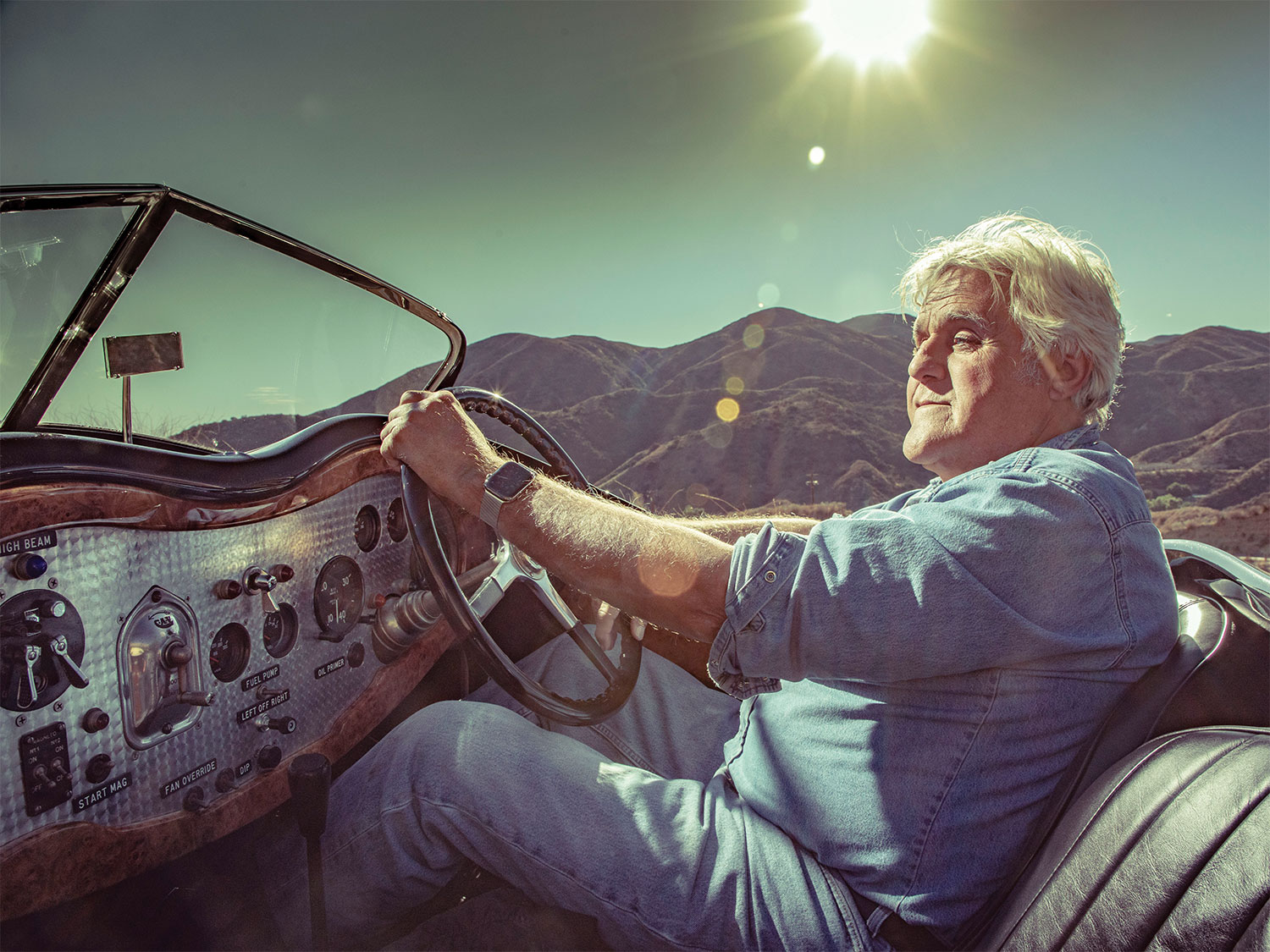
photo by evan klein
Bruce adds, “Most supercars go 200, and now they’re pushing for 300. They take a car like that out to an airport, and they go 300. You may have a car that goes 300, and usually the old guys who can afford one only go 60.”
In March of 2024, the Robb Report aggregated the latest information for the fastest, top speed car. In 1987, the Ferrari F40 broke the second-century mark, setting the benchmark, and creating the race to break the 300 MPH Club. Today, there are 25 cars that are ranked for speed, beginning with the Porsche 918 Spyder at 218 mph at number 25. The top two are the Bugatti Chiron Super Sport at 304.7 mph on the track and the Koenigsegg Jesko Absolut at 330 mph, which is the manufacturer’s claim.
Bruce says he is now in “self-preservation mode.”
“When I turned 75, I stopped running Bonneville. My whole life was motorcycles. But I’ve stopped because people are texting, and it’s kind of dangerous out there. Plus, when you’re in your older years, and you ‘go down,’ you don’t just brush it off. I’ve stopped snow skiing because I didn’t want to get hit by a snowboarder. And I hold onto railings when I go downstairs. Now I want to live and enjoy instead of doing something stupid, which I’m very capable of doing.”
Like his parents, Bruce forbade his children from riding motorcycles. And yet, Bruce once rode his young son on a motorcycle to a birthday party. He directed Evan to hold on to Bruce with one arm and to hold onto the birthday present with the other. Hearing about it from the other mothers, Raylene was very upset.
“It was just so stupid,” admits Bruce.
Turning the conversation towards Jay and his latest serious accidents, Bruce quickly refers to them as “mishaps.”
In 2022, working under his 1907 White Steam car, gas hit Jay’s face, a spark jumped and his face caught on fire. Going to bed that night, the skin from his face and ear melted into the pillow, forcing the doctors to replace his ear and part of his face. Jokingly, he told People magazine, “I tried to get the Clooney face, but it wasn’t available.” In January of this year, while riding on his motorcycle, a 1940s Indian, he hit a wire, was clotheslined and knocked off his bike. Fracturing his collarbone, a few ribs and both kneecaps, the ever-determined Jay returned to his stand-up gigs soon after, still bruised but not broken.
Have these latest events impacted Jay’s thinking? Have they given him pause about his future rides?
“Not at all,” says Jay. “If I didn’t know why the accident happened, then you would go, ‘Oh, I have no idea why that happened or how it happened. I shouldn’t do that.’ But I see what happened. The guy, he had a wire across the road, but he didn’t have a flag on it. The sun was in my eye. It caught me in the neck and threw my face down.”
Bruce quickly chimes in, “Jay’s got another 10 years to go before he’s matured enough to quit.” Jay adds he has one more mishap left in him. “I think I got one,” says Jay lightheartedly.
What about the future of cars?
Jay declares, “You can’t predict the future.”
Bruce agrees.
Jay analogizes, “If you had said 20 years ago, that 20 years from now, it’ll be cool for men to walk with their pants halfway down their ass all the time. Well, that looks ridiculous. It is ridiculous! But I see everybody wearing their underwear up here. Their pants are down there. I go, OK. Why is that? I don’t get it. But if you had predicted that, I’d say, you’re nuts! You just don’t know what will be collectible or what’s in style.”
The electric car today has gotten traction. Jay’s “shock of the new” is subsiding. Most manufacturers are getting into the electric car business. Tesla surpassed early expectations once it was marketed to the masses.
Jay states, “Mark Twain said, ‘I like progress. It’s change I don’t like.’ And that’s kind of what you have here. Tesla has no maintenance, no nothing, and it’s faster than anything else. It’s the fastest thing in my garage right now.”
Bruce drives a Tesla as well. “I hate the fact that I love my car so much. I am on my second Tesla. And Jay drives the high-powered Tesla Plaid.”
In their view, electric cars are here to stay.
Bruce theorizes, “I think the projections on the availability of electricity and what it takes to make electricity hasn’t been thoroughly thought out. If everybody went to electric, we wouldn’t have the grid to support it. I personally think we need to go to nuclear to source our electricity. But that’s like a dirty word. You have to be able to produce energy to run these cars. And I think as time goes on, they’re going to realize by 2030 or 35, it’s not going to all be electric. We couldn’t support it.” After a pause, he adds, “They’re working on synthetic fuels, and I think the hybrid technology can be [the future], even hybrids are pretty darn efficient.”
“Something will evolve,” says Jay, as they continue to ponder the possibilities.
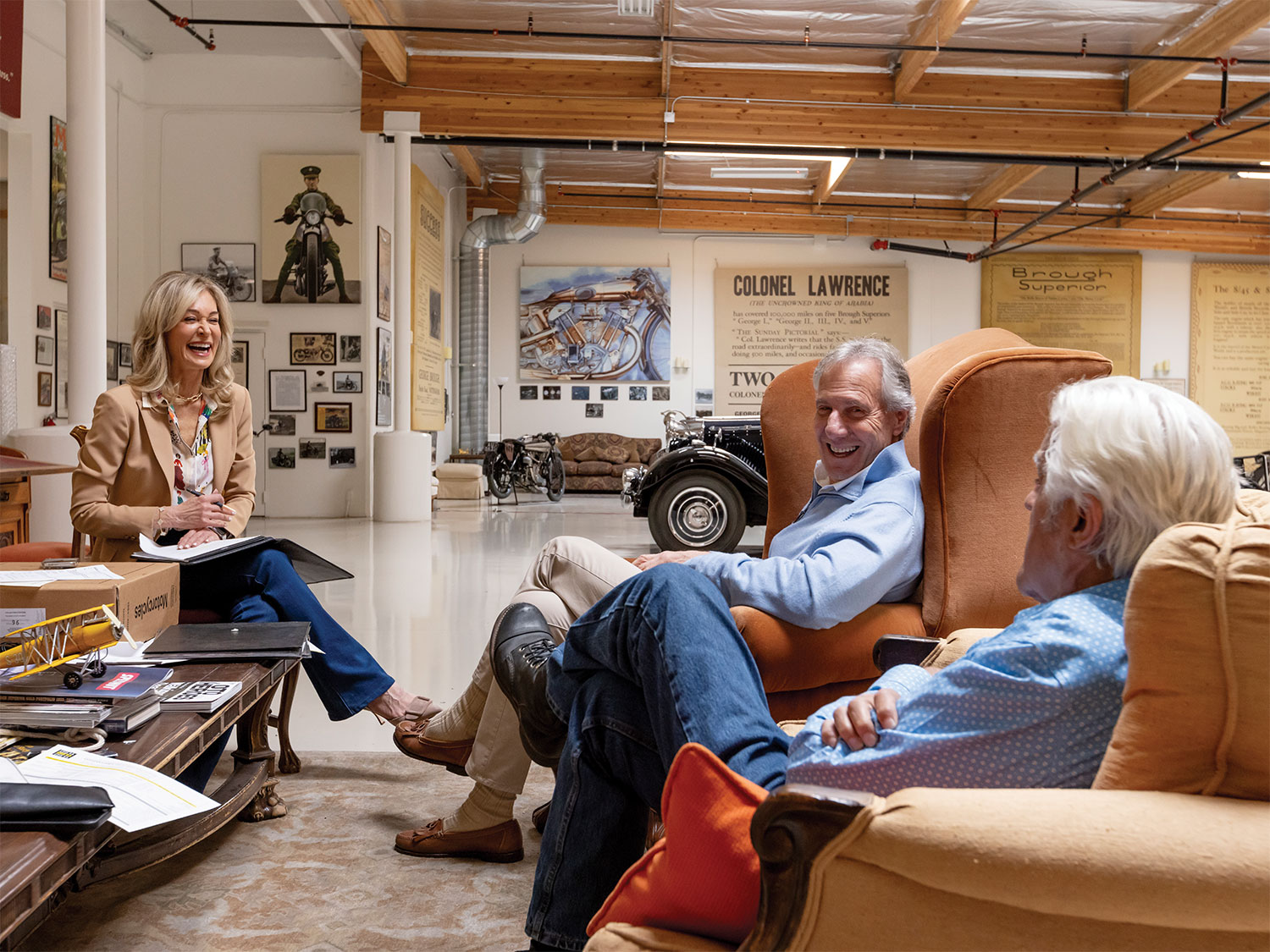
photo by evan klein
Our tour had come full circle. It began with the electric cars of a century ago and ended with the electric marvels of today. While the options for future locomotion are endless, one thing is for sure. These two reigning auto aficionados have indelibly contributed to the legacy of automaking and restoration, and will continue to influence the global car conversation for years to come.
And yet, for Jay and Bruce, it was just another fun day, rapt in their passion, in Jay’s garage.







